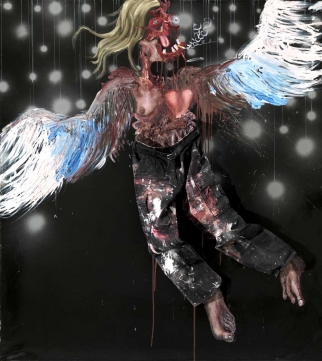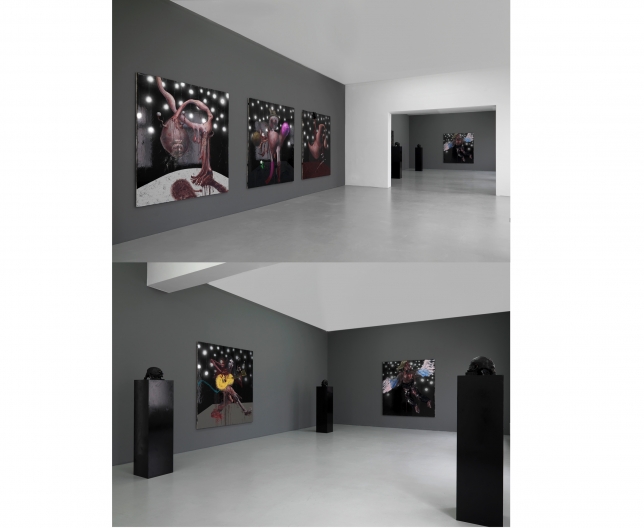02.05.–13.06.09
Andreas Golder
"da steckt ganz viel dahinter"
Solo exhibition at Arndt & Partner, Berlin
Andreas Golder
Born 1979 in Yekaterinburg, Russia
Lives and works in Berlin, Germany
The first impression created by Andreas Golder’s paintings and sculptures is one of expressive directness. Golder clearly identifies to some extent with those young Berlin artists whose bold, forceful immediacy aims to challenge the orderliness of the Leipzig School. The impact created by the way in which he applies paint and the dense working of the canvas in combination with the Baconesque fragmentation of the human body reveal a high level of energy and expression. This energy may be an act of self-liberation from the rigid structures of the academic realism that Golder encountered during his training in Communist Russia. He and his family moved to Germany in 1990 after the fall of the Berlin Wall. The demons he conjures up in his paintings reveal an uncompromising confrontational strategy. At the same time, a subtle irony always permeates his works – either by his choice of titles or by the continuous integration of the grotesque. Brutally deformed body parts are hung over a clothes line (Drama in pyjamas, 2007) and skeletons taking cocaine function as a cynical commentary on contemporary party culture (Disco hangover, 2007). The titles of his deformed sculpture heads – such as Potential hat rack and Still smiling – a medium Golder rediscovered very recently, also turn into an integral element of slapstick.
EXHIBITIONS:
02.05.–13.06.09
Andreas Golder
da steckt ganz viel dahinter
Solo exhibition at Arndt & Partner, Berlin
 Andreas Golder, Krisenengel mit meiner letzten Hose, 2009, oil on canvas, 200 x 180 cm / 78,74 x 70,87 in
Andreas Golder, Krisenengel mit meiner letzten Hose, 2009, oil on canvas, 200 x 180 cm / 78,74 x 70,87 in Exhibitions
PRESS RELEASE
The first impression created by Andreas Golder’s paintings and sculptures is one of expressive directness. Golder clearly identifies to some extent with those young Berlin artists whose bold, forceful immediacy aims to challenge the orderliness of the Leipzig School. The impact created by the way in which he applies paint and the dense working of the canvas in combination with the Baconesque fragmentation of the human body reveal a high level of energy and expression. This energy may be an act of self-liberation from the rigid structures of the academic realism that Golder encountered during his training in Communist Russia. He and his family moved to Ger-many in 1990 after the fall of the Berlin Wall. The demons he conjures up in his paintings reveal an uncompromising confrontational strategy. At the same time, a subtle irony always permeates his works – either by his choice of titles or by the continuous integration of the grotesque. Brutally deformed body parts are hung over a clothes line (Drama in pyjamas, 2007) and skeletons taking cocaine function as a cynical commentary on contemporary party culture (Disco hangover, 2007). The titles of his deformed sculpture heads – such as Potential hat rack and Still smiling – a medium Golder rediscovered very recently, also turn into an integral element of slapstick.
In terms of content, Golder conflates contemporary references from pop, consumer and (local) party culture with existential themes such as death, pain and faith – indicating the artist’s high degree of engagement with himself and the world around him. In his search for a language to realise an idea or a thought about the world or its imagery, Golder ultimately perceives his paintings as being “abstract”. Although some elements reappear in various works, such as the light bulb in his series The artist’s studio (2005), the works never function as narratives. Rather, they are fragments or image constellations of a deconstructed world.
Golder’s fascination with artists such as Francesco de Goya or Hieronymus Bosch is evident both in terms of technique and content. Traditional elements, such as the skull as a memento mori, function as symbols that turn into direct references. The artist consciously utilises a connotative artistic language that allows viewers to decode the works, though only in part and only on the surface. Golder takes his inspiration not only from art and reference books such as the standard encyclopaedia of anatomy, but also from the imagery of contemporary magazines and music cul-ture, from death metal to punk.
Following a very traditional approach, Golder primes his canvases and covers them with a layer of black acrylic, then he applies a clear varnish to achieve the appearance of high-gloss enamel. The quality of directness inherent in the medium of painting is particularly appealing to Golder. It allows him to formally counteract contrasts of content: In his newest works, the high-gloss aes-thetic of the canvas is violated by the assemblage character of the work – cigarette butts, gloves or even the artist’s own trousers, as in Angel of Crisis with my last pair of trousers (2009), turn into Golder’s physical signature on the canvas and function as tools of his creativity.
Formally speaking, the oscillation between abstraction and figuration unites expressionistic and realistic forms of expression, becoming a celebration of the artistic act itself and painting in gen-eral. Golder perceives his own works not in terms of the gruesomeness or ruthlessness of its content, but in terms of the haptic beauty of colour and paint application. What Gilles Deleuze defines in the works of Francis Bacon based on Cézanne’s notion of colouring sensation thus finds a parallel in the radical process of defiguration that occurs in the works of Andreas Golder. Sensations of a complex and personal world are transmitted, and Golder’s canvases turn into a constant testing ground for his ongoing search.
Antonia Josten
